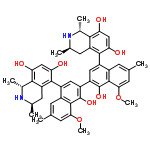Michellamine
 | |
| Names | |
|---|---|
| IUPAC name
(1R,3R,1’R,3’R)-5,5’-(1,1’-dihydroxy-8,8’-dimethoxy-6,6’-dimethyl-2,2’-binaphthalene-4,4’-diyl)bis(1,3-dimethyl-1,2,3,4-tetrahydroisoquinoline-6,8-diol) | |
| Identifiers | |
3D model (JSmol) |
|
| ChemSpider | |
PubChem CID |
|
| |
| |
| Properties | |
| C46H48N2O8 | |
| Molar mass | 756.882 |
Except where otherwise noted, data are given for materials in their standard state (at 25 °C [77 °F], 100 kPa). | |
| Infobox references | |
Michellamine is an atropisomeric alkaloid which has been found to be a strong anti-HIV viral replication inhibitor. It was discovered in the leaves of the Ancistrocladus korupensis which is a member of the Triphyophyllum peltatum found in Cameroon.[1] There are 3 michellamines represented as A, B, and C, however, Michellamine B is the most active against the NID-DZ strain of HIV-2.[2]
Occurrence
Michellamine A and B alkaloids occur naturally in Ancistrocladus korupensis leaves, a Triphyophyllum peltatum found in Cameroon. Bioactive chemical substances including alkaloids, tannins, and saponin are found in several plants in their roots, leaves, stems, flowers, or bark.
Synthesis
There are 2 methods explored to synthesize Michellamines A and B. The first one, originally synthesized in 1994, is a retrosynthesis that leads to a biomimetic pathway that uses the construction of naphthalene/isoquinoline bonds before the naphthalene/naphthalene axis. The second method, originally synthesized only a few montes after the first method, is a complementary pathway that would use the naphthalene/naphthalene axis after it is created and add the 2 isoquinoline moieties.[3]
Medical use
The main use of Michellamines are in anti-HIV medications. They inhibit viral replication of the Protein kinase C and virus-induced cellular fusion.[4] They have a broad range of effectiveness across most HIV strains, particularly the HIV-2 strain, which is found primarily in and around Cameroon.[4]
References
- ↑ Schlauer, Jan; et al. (1 February 1998). "Characterization of Enzymes fromAncistrocladus (Ancistrocladaceae) and Triphyophyllum (Dioncophyllaceae) Catalyzing Oxidative Coupling of Naphthylisoquinoline Alkaloids to Michellamines,, ,". Archives of Biochemistry and Biophysics. 350 (1): 87–94. doi:10.1006/abbi.1997.0494. PMID 9466824.
- ↑ Zhang, Heping; Zembower, David; Chen, Zhidong (October 1997). "Structural analogues of the michellamine anti-HIV agents. Importance of the tetrahydroisoquinoline rings for biological activity". Bioorganic & Medicinal Chemistry Letters. 7 (20): 2687–2690. doi:10.1016/S0960-894X(97)10057-9.
- ↑ Bringmann, Gerhard; Götz, Roland; Keller, Paul A.; Walter, Rainer; Boyd, Michael R.; Lang, Fengrui; Garcia, Alberto; Walsh, John J.; Tellitu, Imanol; Bhaskar, K. Vijaya; Kelly, T. Ross (January 1998). "A Convergent Total Synthesis of the Michellamines". The Journal of Organic Chemistry. 63 (4): 1090–1097. doi:10.1021/jo971495m.
- 1 2 White, E.; Chao, W. R.; Ross, L. J.; Borhani, D. W.; Hobbs, P. D.; Upender, V.; Dawson, M. I. (1999). "Michellamine Alkaloids Inhibit Protein Kinase C". Archives of Biochemistry and Biophysics. 365 (1): 25–30. doi:10.1006/abbi.1999.1145. PMID 10222035.